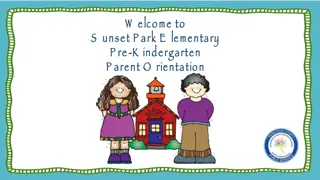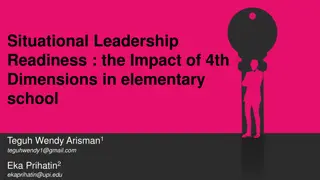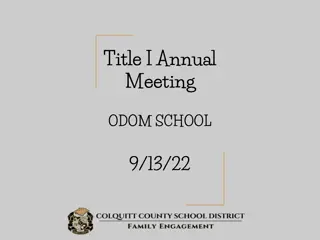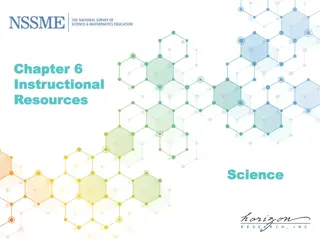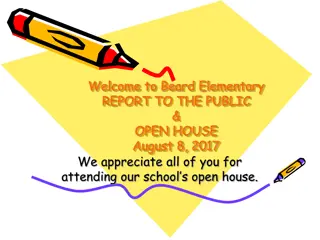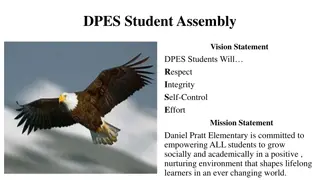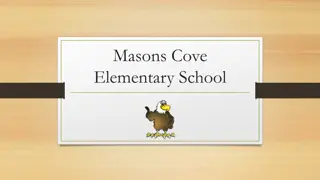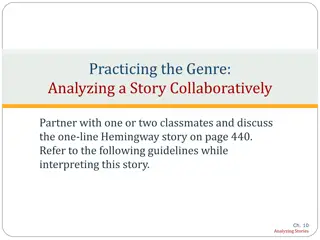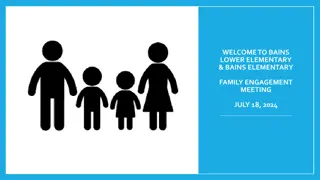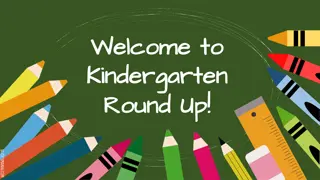Hemingway Elementary School - Read to Succeed Overview
Hemingway Elementary School conducted a parent meeting discussing the Read to Succeed program. The program focuses on third-grade reading proficiency and potential retention if students do not meet the required standards. It outlines expectations for third graders, cut scores for promotion/retention, and Good Cause Exemptions. The program aims to ensure students can read independently and comprehend various texts by the end of the third grade.
Download Presentation

Please find below an Image/Link to download the presentation.
The content on the website is provided AS IS for your information and personal use only. It may not be sold, licensed, or shared on other websites without obtaining consent from the author. Download presentation by click this link. If you encounter any issues during the download, it is possible that the publisher has removed the file from their server.
E N D
Presentation Transcript
HEMINGWAY ELEMENTARY SCHOOL READ TO SUCCEED PARENT MEETING PRESENTERS PATRICIA BURCH, PRINCIPAL ASHLEYN CUMBEE, READING COACH MARIE MURPHY, INSTRUCTIONAL COACH January 26, 2023
READ TO SUCCEED OVERVIEW THE LAW Section 59-155-160 of Read to Succeed states, a student must be retained in the third grade if the student fails to demonstrate reading proficiency at the end of the third grade as indicated by scoring at the lowest achievement level on the state summative reading assessment that equates to Not Met 1 on the Palmetto Assessment of State Standards (PASS).
READ TO SUCCEED OVERVIEW EXPECTATIONS FOR THIRD GRADERS The specific skills that students need in reading are described in the South Carolina College- and Career-Ready (SCCCR) Standards. Designed by stakeholders in South Carolina, the SCCCR Standards outline what students should know and be able to do at the end of each grade level. By the end of third grade, students are expected to be able to read independently and comprehend a variety of texts. This means they can read and understand words, sentences, and paragraphs without help. Third grade students should become self- directed, critical thinkers and readers.
Cut scores determined 177 Third Grade Promotion/Retention Flowchart Student meets proficiency level or cut scores on third grade assessment Student did not meet cut scores or did not attain third grade proficiency on state- identified assessment Student takes 3rd grade state- identified assessment Student promoted to fourth grade Student qualifies for Good Cause Exemption* Student successfully completes SRC Student continues to receive instructional support and services and reading intervention appropriate for their age and reading level Student attends Read to Succeed SRC Student does not meet criteria for successful completion of Read to Succeed SRC Student retained in third grade
*Good Cause Exemptions include students with limited English proficiency and less than two years of instruction in English as a Second Language program; with disabilities whose individual education plan indicates the use of alternative assessments or alternative reading interventions or those whose Individual Education Plan or Section 504 Plan reflects that the student has received intensive remediation in reading for more than two years but still does not substantially demonstrate reading proficiency; who demonstrate third-grade reading proficiency on an alternative assessment approved by the board and which teachers may administer following the administration of the state assessment of reading; who have received two years of reading intervention and were previously retained; who through reading portfolio documents the mastery of the state standards in reading is equal to at least a level above the lowest achievement level on the state reading assessment; and who successfully participate in a summer reading camp at the conclusion of the third grade year and demonstrate through either a reading portfolio or through a norm-referenced, alternative assessment, that their mastery of the state standards in reading is equal to at least a level above the lowest level on the state reading assessment.
THIRD GRADE CLASSROOM EXPECTATIONS
SCHOOL RESPONSIBILITIES
SCHOOL RESPONSIBILITIES Parent Communication: Read to Succeed requires a team approach to assist students not progressing toward grade-level reading proficiency. The classroom teacher, building administrator, and others have a role in involving parents and families as key team members in supporting their student at home as well as at school. Literacy Assessment Portfolio: The purpose of the Literacy Assessment Portfolio (LAP) or a locally developed portfolio (also referred to as a Reading Portfolio) is to provide evidence of a student s progress in the area of literacy. It is a way to collect data that informs teachers, parents, and administrators in determining instructional and intervention decisions. Maintaining a portfolio for every student is good practice; however, Section 59-155-160(A)(5) of Read to Succeed states that all students not demonstrating grade-level proficiency must have a portfolio indicating the intensive instruction and interventions provided. A LAP or a locally developed portfolio is kept each school year a student is not reaching grade-level proficiency in reading. Districts and schools may use the LAP as presented, modify it to better meet individual needs, or use a system of documentation already in place.
SCHOOL RESPONSIBILITIES Intervention: Any student enrolled in prekindergarten, kindergarten, first grade, second grade, or third grade who is substantially not demonstrating proficiency in reading, based upon formal diagnostic assessments or through teacher observations, must be provided intensive in-class and supplemental reading intervention immediately upon determination. The intensive interventions must be provided as individualized and small group assistance based on the analysis of assessment data. All sustained interventions must be aligned with the district's reading proficiency plan. These interventions must be at least thirty minutes in duration and be in addition to ninety minutes of daily reading and writing instruction provided to all students in kindergarten through grade three.
SCHOOL RESPONSIBILITIES Summer Reading Camp (SRC) Districts are required to provide SRCs at the end of a student s third grade year for those students recommended for retention. SRCs are another intervention for students who are still unable to comprehend grade-level texts at this point in time. Third grade students who attend and successfully complete SRC may qualify for a good cause exemption from mandatory retention. Progress Monitoring: Progress monitoring is the standardized process of evaluating progress toward a performance target, based on rates of improvement from frequent assessment of a specific skill. Progress monitoring is used to assess students academic progress, examine rate of improvement, and evaluate effectiveness of instruction or intervention; it is typically used with both individual students and small groups. Progress monitoring can serve a variety of purposes. However, the three main reasons teachers conduct student progress monitoring include (a) evaluating student learning outcomes, (b) considering instructional change, and (c) determining eligibility for other educational services.
HOME INVOLVEMENT 1.Read aloud with your child. Find a comfortable spot where the two of you can read together every day for about 30 minutes. Take turns reading chapters from a book for pleasure, or read books that are above their reading level but are about things that interest them. 2.Encourage all reading. Comic books and magazines can provide a good reading experience. As long as they are age-appropriate, don't discourage their interest, but keep a stock of high-quality books in your home so your child has other options easily available. 3.Keep a dictionary handy. Together, look up words they don't know and invest in a dictionary they can use on their own.
HOME INVOLVEMENT 4. Use informative books. Encourage reading for information. If your child has a science report, help them find books for their research rather than only going to the Web. While the Internet is an easy resource, teach them that books are often more detailed. 5. Discuss the books.Ask your child what an author's main theme is, how characters are alike or different, what they like or dislike about the story, and how it compares to other books they ve read. Share your own thoughts. 6. Expect plateaus. Following some big leaps in their progress, your child may stay at the same reading level for several months. Keep encouraging them and offer praise. 7. Set a good example. Read for your own pleasure and information every day at home, in a room without television


